Sun-prepared foods require careful timing to guarantee safety. You'll need to keep hot foods above 125°F while serving, and you shouldn't leave them out for more than 2-4 hours, depending on the type of food. Fish and seafood have a 2-hour limit at room temperature, while poultry can last up to 4 hours. Cooking times in solar ovens typically take twice as long as traditional methods, and you'll want to pre-heat your solar oven to at least 140°F to prevent bacterial growth. The storage duration of your sun-prepared foods depends on several factors, including temperature, humidity, and how you package them afterward.
Solar Cooking Temperature Safety Basics
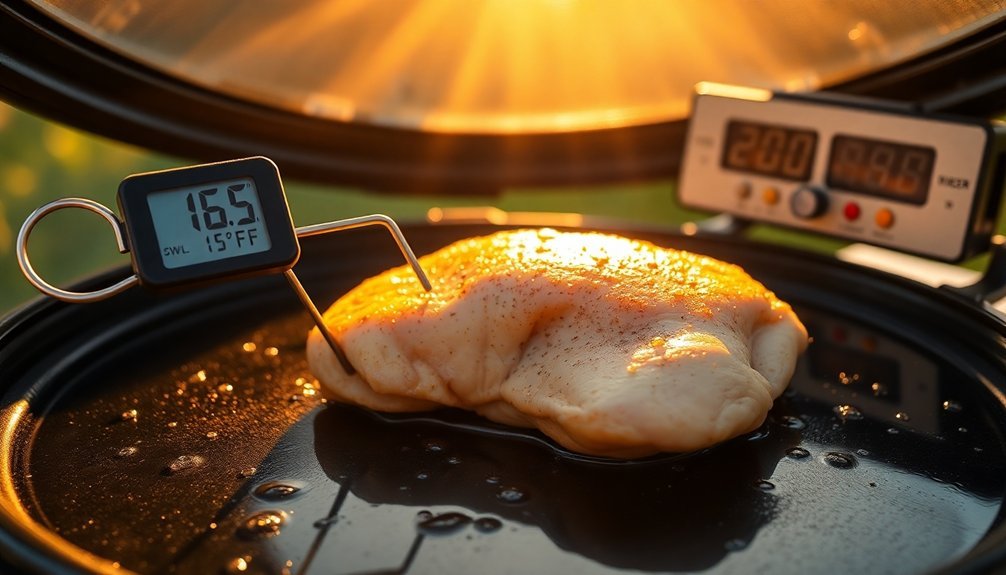
When using a solar cooker, understanding temperature safety is critical for preparing food safely and effectively.
You'll need to maintain temperatures between 200°F and 300°F for most cooking tasks, while ideal roasting and simmering occur between 180°F and 250°F.
Solar cooking requires twice the time compared to traditional cooking methods. To guarantee food safety, you must pre-heat your solar oven above 140°F before adding food. This helps you avoid the dangerous temperature zone of 40°F to 140°F where bacteria can thrive.
You'll get better temperature control with larger, well-insulated ovens, especially those equipped with parabolic wings and large reflectors to concentrate sunlight.
Always use a digital probe thermometer to monitor internal food temperatures: 145°F for whole cuts of meat, 160°F for ground meats, and 165°F for poultry.
These temperatures assure your food is safe to eat.
Meat Storage During Sun Preparation
Since proper storage is essential during sun preparation, you'll need to protect your meat from contamination and temperature fluctuations throughout the process.
Suspend individual meat strips using hooks or clips rather than branches or wire, guaranteeing they don't touch each other to maintain proper air circulation. Smoke and spices can be applied during this phase to enhance preservation and flavor.
You'll want to choose lean cuts and trim excess fat before preparation, as fat content can lead to rancidity.
Cut the meat into uniform, thin strips to guarantee even drying. While drying, monitor the balance between surface and internal moisture carefully.
For ideal results, dry your meat in warm, low-humidity conditions (around 30%) with steady temperatures between day and night.
Once dried, store your meat in airtight glass, stainless steel, or food-grade plastic containers. You can also vacuum seal and freeze it for extended preservation.
Poultry Time Limits
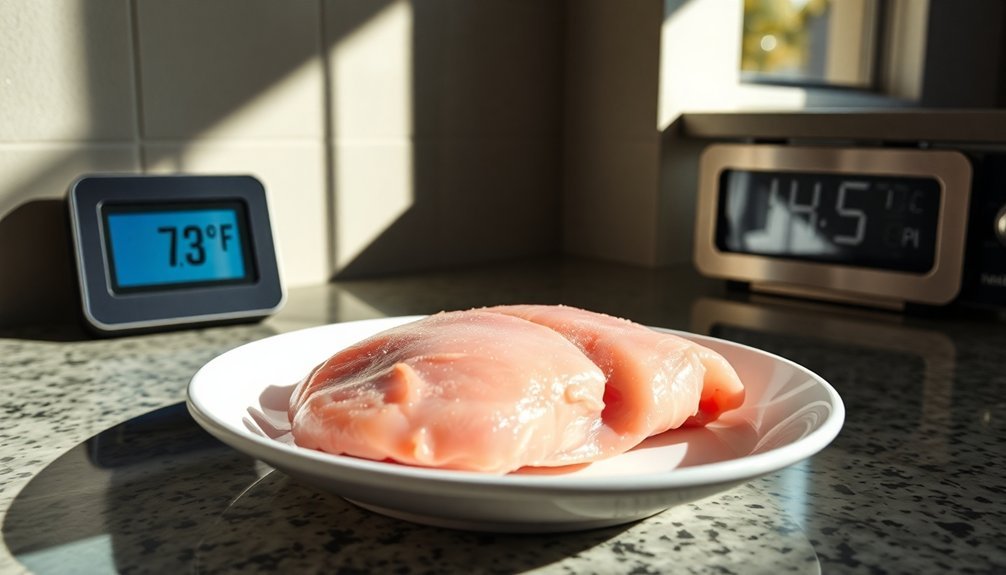
Because poultry can quickly become unsafe to eat, you'll need to follow strict time limits for storage and preparation. When preparing poultry in the sun, you must adhere to the 4-hour maximum rule at room temperature to prevent foodborne illness.
Fresh chicken, turkey, duck, and their parts shouldn't stay above 40°F (4°C) for more than this timeframe. Store raw poultry on the lower refrigerator shelf to prevent cross-contamination with other foods.
For food safety, you'll want to keep raw poultry refrigerated at or below 40°F if you're not using it immediately. Fresh whole birds and pieces last only 1-2 days in the refrigerator, while cooked poultry remains safe for 3-4 days.
If you're planning to store your poultry longer, freeze it instead – whole chickens can last up to a year, while pieces stay good for 9 months.
Fish and Seafood Guidelines
While fresh fish and seafood offer excellent nutritional value, they're among the most perishable foods you'll handle.
You'll need to maintain strict temperature control at 40°F or below to guarantee safety and prevent bacterial growth. If you're preparing fish outdoors or in the sun, you can't leave it at room temperature for more than 2 hours, and even less on hot days. Sunlight and heat exposure can accelerate bacterial growth dramatically.
- Gut, bleed, and wash your fish immediately after catching to minimize spoilage risks.
- Don't let raw fish sit between 70°F and 135°F for more than 2 hours.
- If you're storing fish in the refrigerator, use it within 2 days.
- Consider preservation methods like salting, smoking, or drying if you won't use the fish right away – these techniques can extend shelf life from 24 hours to several months.
Dairy Products in Solar Cooking
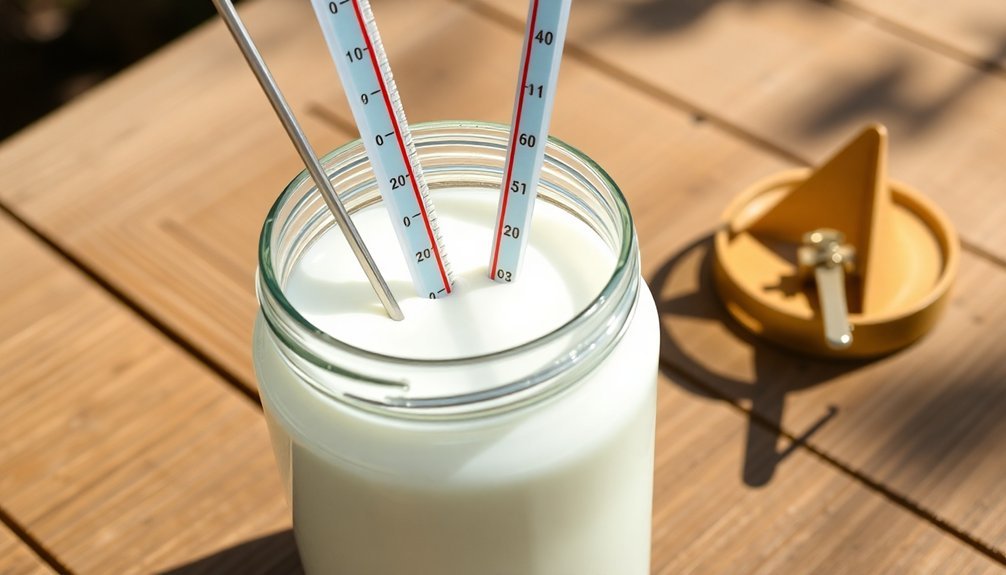
Although dairy products can be safely prepared in solar cookers, they need special attention to prevent spoilage and maintain quality. You'll want to monitor temperatures carefully, as solar ovens can reach up to 250°F (121°C), which is suitable for warming dairy products. On cloudy days, you can expect temperatures between 200-250°F (93-121°C).
When cooking with dairy, use pot holders for safety and keep your containers covered to retain heat and prevent contamination. You'll get better results by adding dairy ingredients toward the end of cooking time to avoid curdling.
For efficient heating, use dark-colored containers and check temperatures regularly with a thermometer. Remember to store your dairy products in cool, shaded areas after cooking and always maintain cleanliness to prevent bacterial growth.
Vegetable Solar Storage Requirements
Proper storage preparation is essential for solar-dried vegetables to maintain their quality and extend shelf life.
You'll need to verify your vegetables are completely dried before storage, as any remaining moisture can lead to fungal growth and spoilage. When storing your solar-dried vegetables, use thick plastic bags and seal them tightly to prevent moisture from getting in.
- Blanch your vegetables properly before drying (3 minutes for tomatoes, 1 minute for leafy greens) to preserve color and texture.
- Allow vegetables to dry completely – leafy greens take 1 day, while tomatoes need 1-3 days.
- Pack dried vegetables in thick, well-sealed plastic bags.
- Store in a cool, dry place where they'll last for more than six months.
With proper preparation and storage, you'll successfully preserve your vegetables while maintaining their nutritional value.
Fruit Preservation Methods
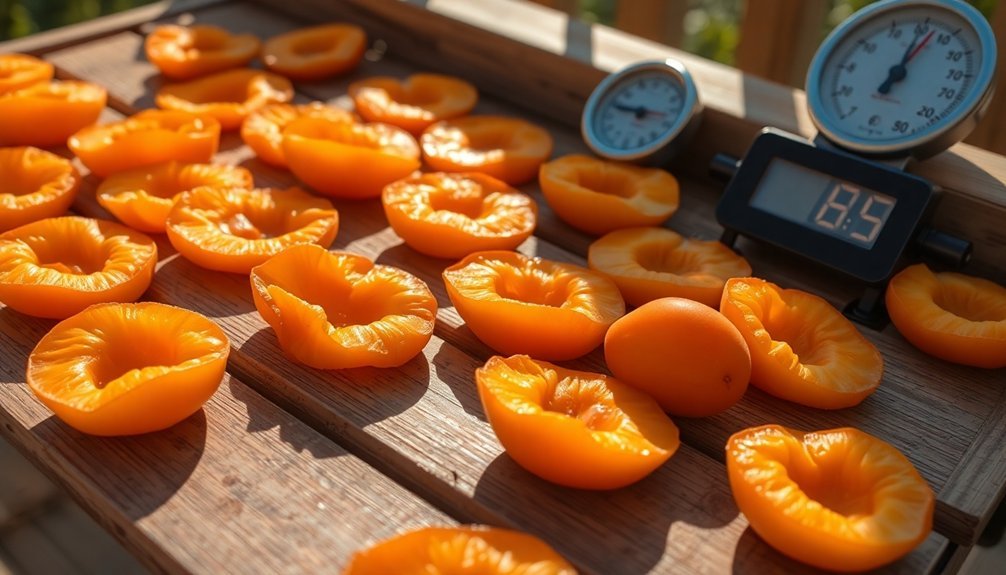
Successfully preserving fruit requires choosing the right method based on your needs and available equipment. You'll find several effective options, from traditional sun drying to modern freeze-drying technology.
If you're in a sunny climate above 98°F, sun drying offers a natural preservation method – just place fruit on trays with proper air circulation and protect it with cheesecloth.
For more controlled results, you can use your home oven or a dedicated dehydrator, which provides consistent temperature and airflow. Freeze-drying delivers premium results but requires specialized equipment.
For simpler preservation, refrigeration works well short-term, while freezing offers long-term storage. You'll want to try flash freezing to maintain texture, or experiment with freezing in olive oil for unique treats.
Remember to properly wash and prepare your fruit before using any preservation method.
Solar Cooked Grain Storage
You'll need to maintain your solar-dried grain between 30-40°F, with northern regions aiming for the lower end of that range and southern regions the higher end.
Your cooling process should begin immediately after solar drying, using aeration systems to gradually bring down the temperature and prevent moisture migration.
To control moisture effectively, you'll want to place storage containers on elevated, well-drained surfaces and use properly spaced ducts for uniform airflow.
Safe Storage Temperature Range
Maintaining precise storage temperatures for solar-cooked grains is essential to prevent harmful bacterial growth.
You'll need to keep your solar-cooked foods out of the danger zone between 40°F and 140°F (5°C to 57°C), where bacteria thrive and multiply rapidly. If you're not serving your cooked grains immediately, cool them quickly to below 50°F (10°C) for safe storage.
- Store your cooked grains at 5°C or below if you're planning to eat them later
- Keep hot foods above 125°F (52°C) if you're serving them soon
- Don't leave cooked grains in the solar cooker overnight unless properly cooled
- Monitor storage temperatures regularly to guarantee food stays out of the danger zone
Remember that reheating won't eliminate toxins that develop when food sits in unsafe temperature ranges.
Cooling Time Requirements
Proper cooling of solar-cooked grains requires careful timing and temperature monitoring to guarantee food safety.
You'll want to initiate cooling cycles when the air temperature is 10-20 degrees F lower than your grain temperature, aiming for a final temperature between 30-40 degrees F.
To calculate your cooling time, divide 15 by your airflow rate (cfm/bu). For instance, if you're using 0.15 cfm/bu, you'll need about 100 hours to cool the bin completely.
Don't rush this process – it's essential to wait until the cooling front reaches the top of the grain. You can verify completion by checking the temperature 6-12 inches into the grain at multiple points on the surface.
Remember to run your aeration fans during cool mornings and avoid cooling below 30 degrees F to prevent ice formation.
Moisture Control Methods
Successful storage of solar-cooked grains hinges on precise moisture control.
You'll need to adjust moisture content for each grain type, with wheat and corn requiring 13.5%, barley 12%, and soybeans 11%.
Always warm your grain samples to room temperature in sealed plastic bags before testing moisture levels to guarantee accurate readings.
- Measure grain moisture using calibrated meters adjusted for temperature
- Store grains in sealed, well-ventilated containers to maintain ideal moisture levels
- Keep storage areas cool, as every 10°C temperature increase cuts storage life in half
- Monitor moisture regularly and adjust conditions if you notice condensation
Remember that market moisture levels often exceed long-term storage requirements, so you'll need to dry your grains further before storing.
This precaution prevents mold growth and extends storage life considerably.
Legume Storage After Sun Cooking
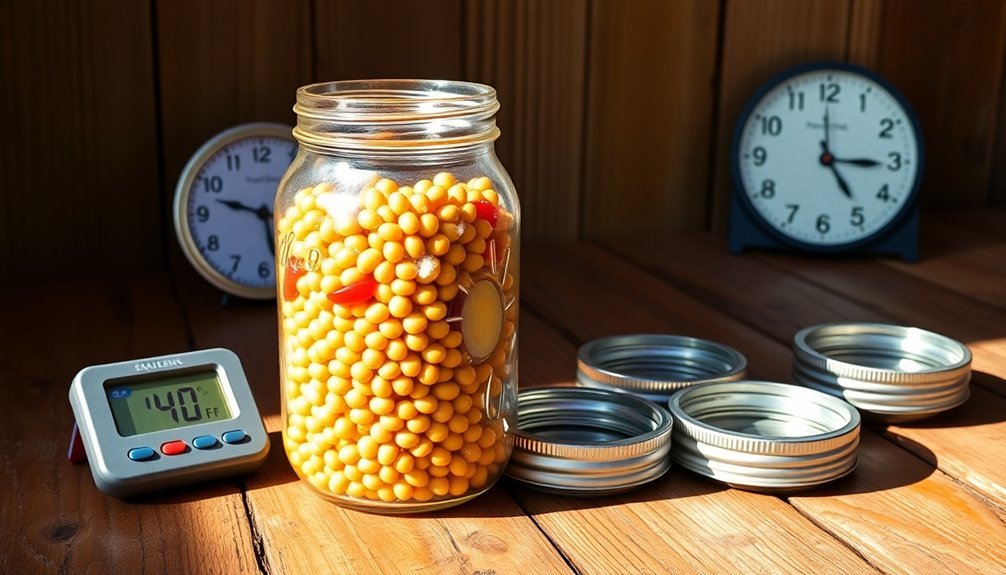
You'll need to cool your sun-cooked legumes quickly to between 50-70°F before storage to prevent bacterial growth and maintain food safety.
When storing your cooled legumes, keep them in separate airtight containers from other foods to avoid cross-contamination and potential spoilage.
Transfer your legumes to the refrigerator within 2 hours of cooking, using clean utensils and containers to maintain proper food handling standards.
Storage Temperature Ranges
When storing legumes after sun cooking, maintaining the right temperature range is essential for preserving their quality and extending shelf life.
You'll want to keep your sun-prepared legumes in areas below 75°F (24°C) to prevent rapid deterioration and nutrient loss. A basement or cool, dry storage space provides ideal conditions, while you should avoid attics, garages, or crawl spaces that experience temperature fluctuations.
- Store your legumes in airtight containers at consistent temperatures
- Keep humidity levels under 15% using dehumidifiers if needed
- Choose a storage location away from direct sunlight and heat sources
- Monitor your storage area regularly to guarantee temperatures don't exceed 75°F
Quick Cooling Methods
Proper cooling of sun-cooked legumes stands equally important as maintaining storage temperatures. You'll need to cool your legumes quickly using one of several effective methods to prevent bacterial growth and maintain food safety.
| Method | Best For | Key Steps |
|---|---|---|
| Ice Bath | Thick legume dishes | Place container in ice-water mixture, stir every few minutes |
| Ice Cubes | Soupy legumes | Add ice directly, stir frequently for even cooling |
| Shallow Pans | All legume types | Spread in 4-inch layers, leave uncovered |
For faster cooling, you can combine these methods. Start by transferring your legumes to shallow pans, then place them in an ice bath while stirring periodically. If you have access to professional equipment, a blast chiller offers the most efficient cooling, bringing temperatures down rapidly while maintaining food quality.
Cross-Contamination Prevention
Storing sun-cooked legumes safely requires strict attention to cross-contamination prevention.
You'll need to protect your freshly prepared legumes from contact with raw foods, especially meat, poultry, and fish. Keep your sun-cooked legumes on the upper shelves of your storage area, with any raw ingredients stored below to prevent drips or spills from contaminating your prepared food.
- Use dedicated cutting boards and utensils for your sun-cooked legumes, separate from those used for raw meats.
- Keep your legumes covered until serving time to protect them from environmental contaminants.
- Wash your hands thoroughly before handling the cooked legumes.
- Sanitize all storage containers, countertops, and utensils before transferring your sun-cooked legumes.
Remember to label your storage containers with the preparation date and keep them sealed to maintain freshness and prevent contamination.
Safe Cooling Periods
To guarantee food safety in sun-prepared dishes, you'll need to follow strict cooling periods that occur in two distinct phases.
The first phase requires you to cool your food from 135°F to 70°F within 2 hours. During this vital period, you should use shallow pans or divide food into smaller portions to speed up the process.
The second phase involves cooling from 70°F to 41°F or below within the next 4 hours. You'll want to use ice water baths or metal containers to achieve this effectively.
Throughout both phases, monitor the internal temperature with a calibrated probe thermometer. Don't leave food at room temperature or cool it without proper ventilation.
Container Selection for Solar Foods
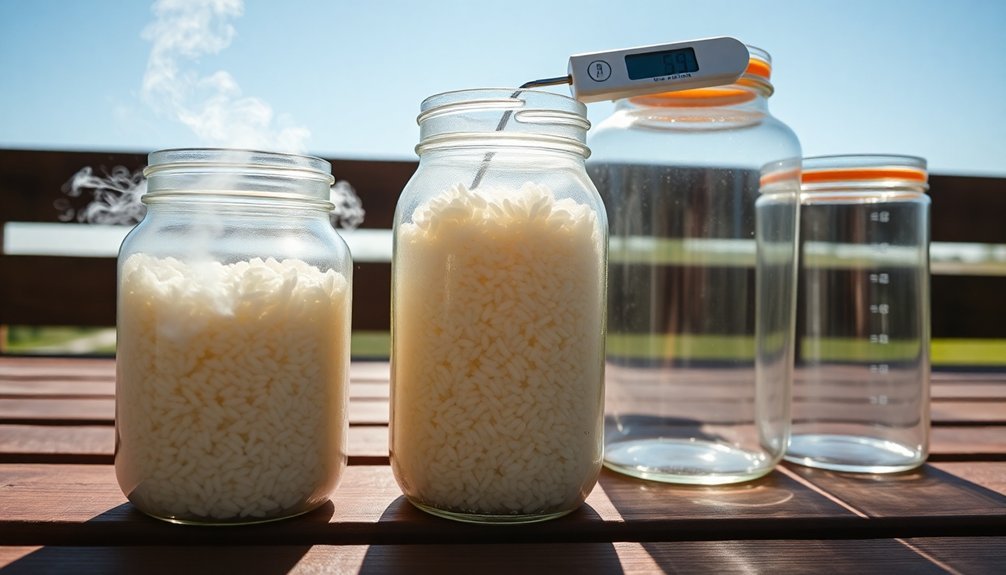
When selecting containers for solar cooking, you'll want to prioritize dark-colored metal or enamel pots that are food-safe and non-toxic for ideal heat absorption and safety.
Your containers should feature tight-fitting lids and proper insulation to maintain consistent cooking temperatures, especially during cloudy periods.
While stackable containers can maximize space in box-style solar cookers, you're better off using spread-out, shallow containers in parabolic cookers to capture focused sunlight more effectively.
Materials For Safe Storage
Safe storage of sun-prepared food begins with selecting the right container specifications and materials.
You'll find that modern cold storage solutions offer temperature control between 3°C to 20°C, perfect for preserving sun-prepared foods. The walls and ceiling use 100mm thick PIR panels with slip joints, while floors feature non-slip aluminum sheets over 12mm WBP plywood.
- Choose from various modular sizes (2x2m, 3x3m, or 5x5m) based on your storage needs
- Benefit from pre-assembled components that include solar panels and cooling units
- Store food in reusable crates within walk-in cold rooms
- Maintain consistent temperatures using VacKool cooling units that extend food shelf life from 2 to 21 days
These materials and specifications guarantee your sun-prepared food stays fresh and safe for consumption.
Insulation And Heat Control
Building on proper storage materials, effective insulation and heat control play a central role in preserving sun-prepared foods.
You'll need to select dark, non-reflective containers that absorb sunlight efficiently and maintain consistent temperatures. High-temperature baking bags can help retain heat around your food during the cooking process.
For ideal heat retention, you'll want to make sure your solar cooker has proper glazing and insulation to maintain thermal equilibrium. The container should be airtight to prevent heat loss through convection and conduction.
When using a parabolic cooker, place your pot at the focal point for maximum heat concentration.
Consider using thick PIR panels or twin wall polycarbonate barriers if you're storing food in a solar-powered cold storage system, as these materials can greatly reduce heat transfer and improve energy efficiency.
Stackable Vs Spread Design
Choosing between stackable and spread designs for solar food storage depends largely on your specific needs and available space.
Stackable containers offer excellent organization and space efficiency, making them perfect for storing your dried foods in cabinets or fridges.
Meanwhile, spread designs with mesh shelving provide superior air circulation and even drying during the dehydration process.
- Opt for stackable containers when you're prioritizing storage efficiency and need to keep dried foods organized in limited space.
- Select spread designs when you're actively drying foods, as they prevent moisture from getting trapped between layers.
- Use stackable containers for long-term storage and transportation of finished dried goods.
- Choose spread designs with mesh shelving when you need to dry large quantities of food simultaneously and monitor the process closely.
Weather Impact on Storage Duration
Weather conditions play an essential role in determining how long you can store sun-prepared food. You'll need to monitor temperature, humidity, and light exposure carefully to maintain food safety and quality.
| Weather Factor | Impact on Storage |
|---|---|
| Temperature | Keep below 70°F; every 10°C rise doubles spoilage rate |
| Humidity | High levels promote mold; low levels cause food to dry out |
| Sunlight | Avoid direct exposure to prevent nutrient loss and temperature spikes |
Your storage environment directly affects shelf life. In hot conditions above 100°F, you'll notice faster spoilage and potential damage to containers. When storing sun-prepared foods, you'll want to maintain consistent temperatures below 85°F and control moisture levels. Don't store food in damp areas like basements or garages, as these conditions can compromise food safety through rust and bacterial growth.
Emergency Storage Solutions
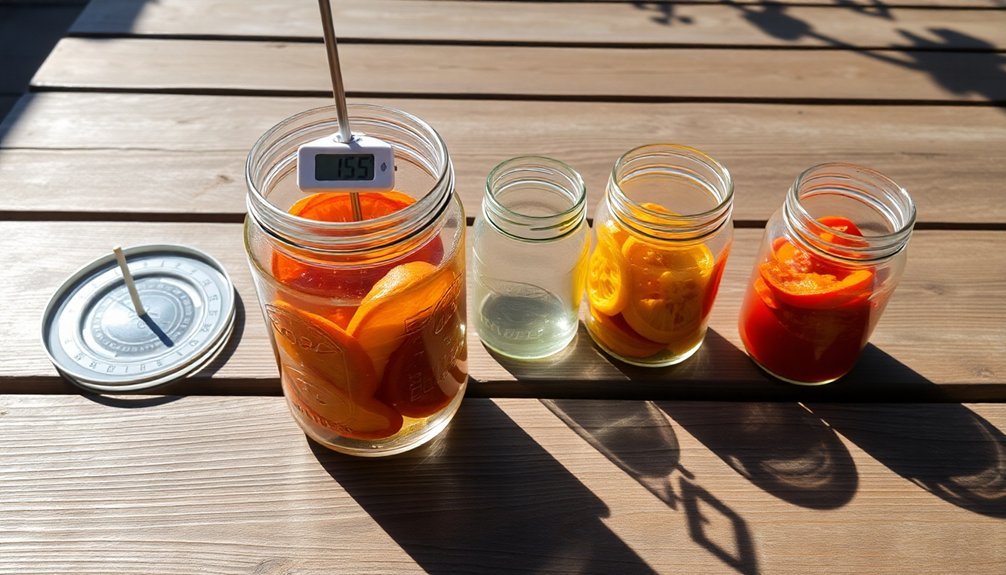
When emergencies strike, maintaining a reliable food storage system becomes critical for your household's survival. You'll need to focus on storing shelf-stable items in airtight, moisture-proof containers away from direct light. Select ready-to-eat canned goods, high-energy foods, and comfort items that match your family's dietary needs.
- Store your emergency food supplies in proper containers: zipper-closure bags, glass jars with screw-top lids, or non-rusty metal cans.
- Keep track of expiration dates and rotate items regularly – powdered milk lasts six months, while canned soups last one year.
- Don't forget essential equipment like can openers, disposable utensils, and cooking devices.
- Include extra water for rehydrating freeze-dried foods and maintaining proper food preparation standards.
Remember to store indefinitely-lasting items like wheat, vegetable oils, and baking powder as your storage foundation.
Frequently Asked Questions
Can Sun-Prepared Food Be Safely Reheated Multiple Times After Initial Cooking?
You shouldn't reheat sun-prepared food multiple times. It's best to reheat only once to minimize bacterial growth and food safety risks. Store portions individually and reheat them only when you're ready to eat.
How Does Altitude Affect the Maximum Storage Time for Sun-Prepared Foods?
Your altitude won't directly affect storage time for sun-prepared foods. You'll need to follow standard storage guidelines – keeping foods in cool, dry places – regardless of elevation to maintain their shelf life.
Do Different Colored Containers Impact the Safety of Sun-Prepared Food Storage?
While container color isn't essential, you'll find that darker containers offer better light protection. What matters most is that your container's airtight, moisture-proof, and made of suitable materials like glass or metal.
Are There Specific Serving Utensils That Extend Sun-Prepared Food's Safe Consumption Time?
No, serving utensils don't extend food's safe time in the sun. You'll still need to follow the two-hour rule (one hour above 90°F), regardless of what utensils you're using to serve the food.
Can Aromatics and Spices Increase the Safe Storage Duration of Sun-Prepared Foods?
Yes, you can extend your sun-prepared food's storage life by adding aromatics and spices. They contain natural antimicrobial properties that help preserve food, but you'll still need proper drying and storage techniques.
In Summary
You'll need to follow strict time limits when solar cooking, even in ideal conditions. Don't leave meat dishes in the sun longer than 2 hours at 90-140°F (32-60°C), or 1 hour when temperatures exceed 90°F (32°C). For best safety, consume your sun-prepared foods within these timeframes and always use a food thermometer to verify proper cooking temperatures. Store leftovers immediately in insulated containers.

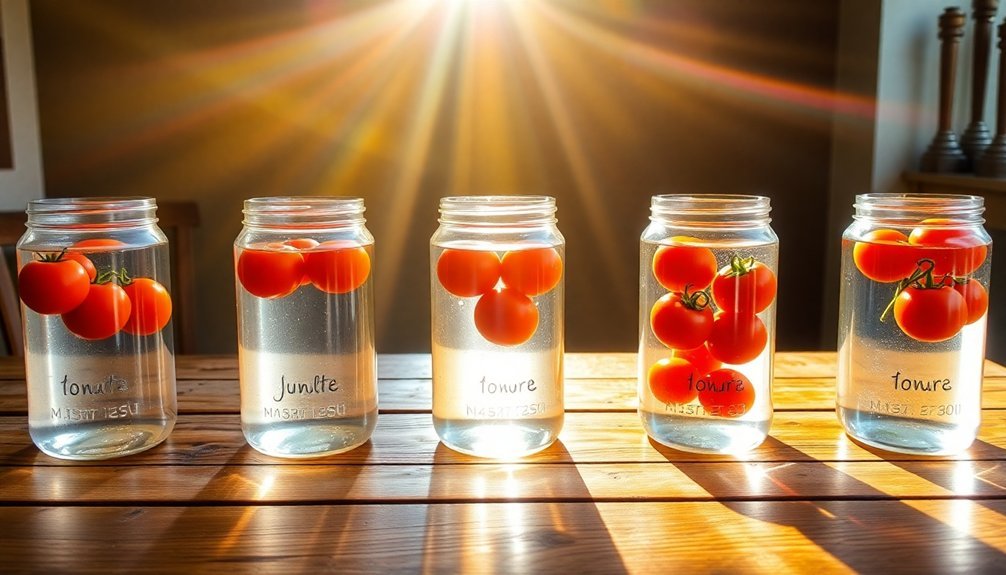



Leave a Reply